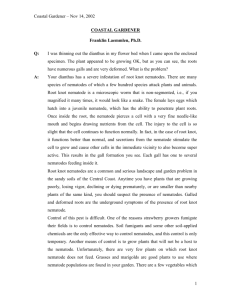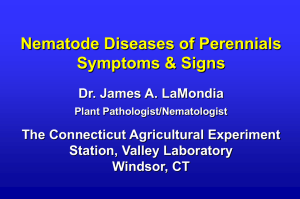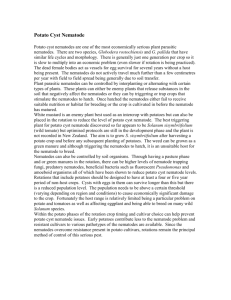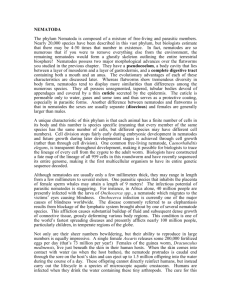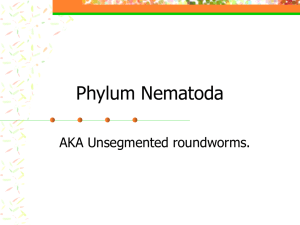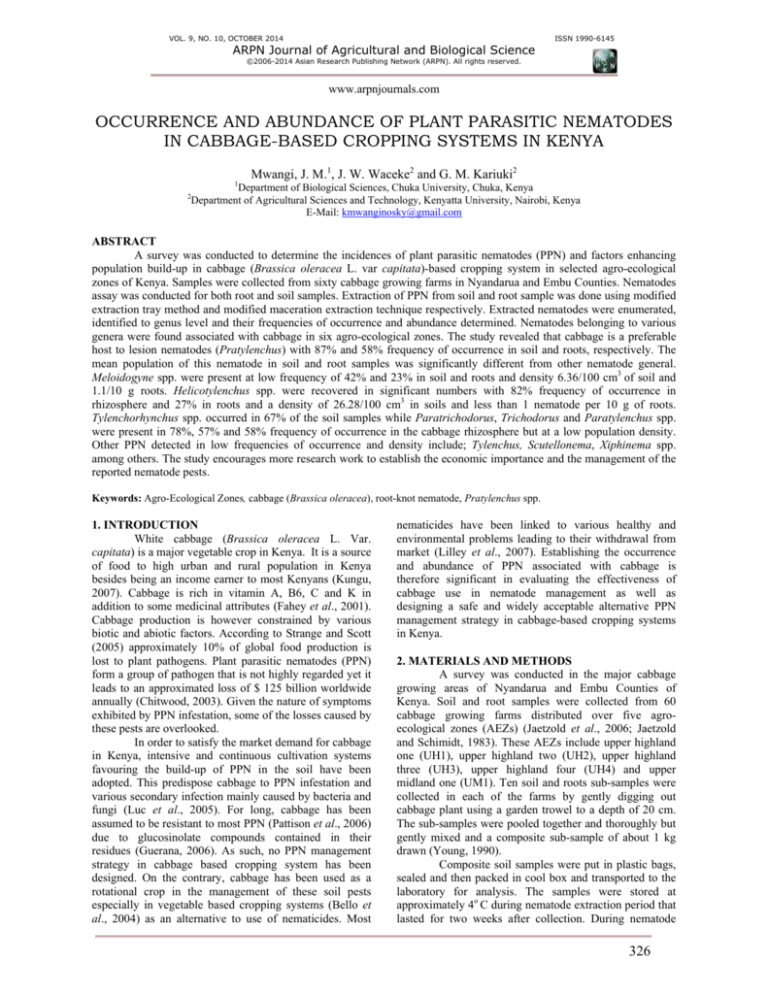
VOL. 9, NO. 10, OCTOBER 2014
ISSN 1990-6145
ARPN Journal of Agricultural and Biological Science
©2006-2014 Asian Research Publishing Network (ARPN). All rights reserved.
www.arpnjournals.com
OCCURRENCE AND ABUNDANCE OF PLANT PARASITIC NEMATODES
IN CABBAGE-BASED CROPPING SYSTEMS IN KENYA
1
Mwangi, J. M.1, J. W. Waceke2 and G. M. Kariuki2
Department of Biological Sciences, Chuka University, Chuka, Kenya
Department of Agricultural Sciences and Technology, Kenyatta University, Nairobi, Kenya
E-Mail: kmwanginosky@gmail.com
2
ABSTRACT
A survey was conducted to determine the incidences of plant parasitic nematodes (PPN) and factors enhancing
population build-up in cabbage (Brassica oleracea L. var capitata)-based cropping system in selected agro-ecological
zones of Kenya. Samples were collected from sixty cabbage growing farms in Nyandarua and Embu Counties. Nematodes
assay was conducted for both root and soil samples. Extraction of PPN from soil and root sample was done using modified
extraction tray method and modified maceration extraction technique respectively. Extracted nematodes were enumerated,
identified to genus level and their frequencies of occurrence and abundance determined. Nematodes belonging to various
genera were found associated with cabbage in six agro-ecological zones. The study revealed that cabbage is a preferable
host to lesion nematodes (Pratylenchus) with 87% and 58% frequency of occurrence in soil and roots, respectively. The
mean population of this nematode in soil and root samples was significantly different from other nematode general.
Meloidogyne spp. were present at low frequency of 42% and 23% in soil and roots and density 6.36/100 cm3 of soil and
1.1/10 g roots. Helicotylenchus spp. were recovered in significant numbers with 82% frequency of occurrence in
rhizosphere and 27% in roots and a density of 26.28/100 cm3 in soils and less than 1 nematode per 10 g of roots.
Tylenchorhynchus spp. occurred in 67% of the soil samples while Paratrichodorus, Trichodorus and Paratylenchus spp.
were present in 78%, 57% and 58% frequency of occurrence in the cabbage rhizosphere but at a low population density.
Other PPN detected in low frequencies of occurrence and density include; Tylenchus, Scutellonema, Xiphinema spp.
among others. The study encourages more research work to establish the economic importance and the management of the
reported nematode pests.
Keywords: Agro-Ecological Zones, cabbage (Brassica oleracea), root-knot nematode, Pratylenchus spp.
1. INTRODUCTION
White cabbage (Brassica oleracea L. Var.
capitata) is a major vegetable crop in Kenya. It is a source
of food to high urban and rural population in Kenya
besides being an income earner to most Kenyans (Kungu,
2007). Cabbage is rich in vitamin A, B6, C and K in
addition to some medicinal attributes (Fahey et al., 2001).
Cabbage production is however constrained by various
biotic and abiotic factors. According to Strange and Scott
(2005) approximately 10% of global food production is
lost to plant pathogens. Plant parasitic nematodes (PPN)
form a group of pathogen that is not highly regarded yet it
leads to an approximated loss of $ 125 billion worldwide
annually (Chitwood, 2003). Given the nature of symptoms
exhibited by PPN infestation, some of the losses caused by
these pests are overlooked.
In order to satisfy the market demand for cabbage
in Kenya, intensive and continuous cultivation systems
favouring the build-up of PPN in the soil have been
adopted. This predispose cabbage to PPN infestation and
various secondary infection mainly caused by bacteria and
fungi (Luc et al., 2005). For long, cabbage has been
assumed to be resistant to most PPN (Pattison et al., 2006)
due to glucosinolate compounds contained in their
residues (Guerana, 2006). As such, no PPN management
strategy in cabbage based cropping system has been
designed. On the contrary, cabbage has been used as a
rotational crop in the management of these soil pests
especially in vegetable based cropping systems (Bello et
al., 2004) as an alternative to use of nematicides. Most
nematicides have been linked to various healthy and
environmental problems leading to their withdrawal from
market (Lilley et al., 2007). Establishing the occurrence
and abundance of PPN associated with cabbage is
therefore significant in evaluating the effectiveness of
cabbage use in nematode management as well as
designing a safe and widely acceptable alternative PPN
management strategy in cabbage-based cropping systems
in Kenya.
2. MATERIALS AND METHODS
A survey was conducted in the major cabbage
growing areas of Nyandarua and Embu Counties of
Kenya. Soil and root samples were collected from 60
cabbage growing farms distributed over five agroecological zones (AEZs) (Jaetzold et al., 2006; Jaetzold
and Schimidt, 1983). These AEZs include upper highland
one (UH1), upper highland two (UH2), upper highland
three (UH3), upper highland four (UH4) and upper
midland one (UM1). Ten soil and roots sub-samples were
collected in each of the farms by gently digging out
cabbage plant using a garden trowel to a depth of 20 cm.
The sub-samples were pooled together and thoroughly but
gently mixed and a composite sub-sample of about 1 kg
drawn (Young, 1990).
Composite soil samples were put in plastic bags,
sealed and then packed in cool box and transported to the
laboratory for analysis. The samples were stored at
approximately 4o C during nematode extraction period that
lasted for two weeks after collection. During nematode
326
VOL. 9, NO. 10, OCTOBER 2014
ISSN 1990-6145
ARPN Journal of Agricultural and Biological Science
©2006-2014 Asian Research Publishing Network (ARPN). All rights reserved.
www.arpnjournals.com
extraction, each sample was thoroughly mixed and a 100
cm3 sub-sample was collected for nematode extraction
using modified Baermann funnel technique as described
by Hooper et al., (2005). Extracted nematodes were
enumerated using a stereomicroscope and identified to
genus level based on morphological features as described
by Hunt, et al., (2005), Siddiqi, (2000) and the University
of Nebraska Lincoln nematode identification website
(http://nematode.unl.edu/konzlistbutt.htm)
Root samples were washed and examined for
galls. A sample of root was stained for egg masses
according to Holbrook et al., (1983). Nematodes were also
extracted from roots using a modified maceration and
filtration technique according to Hooper et al., (2005) and
thereafter enumerated and identified to genus levels at
various magnifications as described earlier. Mean
nematodes densities were compared using analysis of
variance (ANOVA). Means that were significantly
different (P≤0.05) were separated by LSD. Absolute
frequency was determined using the following formula;
3. RESULTS
A total of eighteen (18) genera of plant parasitic
nematodes were identified from the soil and the root
samples in the six agro-ecological zones (Table-1).
Table-1. Plant parasitic nematodes genera isolated from soils and roots of cabbage in
Nyandarua and Embu Agro-Ecological Zones.
Order
Sub-order
Family
Genus
Pratylenchidae
Pratylenchus
Helicotylenchus
Hoplolaimus
Rotylenchulus
Peltamigratus
Scutellonema
Meloidogyne
Hoplolaimidae
Tylenchida
Meloidogynidae
Tylenchina
Criconematidae
Tylenchulidae
Tylenchorhynchidae
Paratylenchidae
Dorylaimida
Triplonchida
Dorylaimina
Diphtherophorina
Longidoridae
Trichodoridae
Plant parasitic nematodes were detected in nearly
every sample but at varying frequencies and densities.
Paratrichodorus and Filenchus spp. were present in all
AEZs at high frequencies. Pratylenchus and
Helicotylenchus spp. occurred in high frequencies in five
out of the six AEZs while Hemicycliophora and
Longidorus occurred in 50% of the sample. Six nematode
genera were present in both cabbage roots and soils,
namely: Pratylenchus (lesion), Helicotylenchus (spiral),
Meloidogyne
(root
knot),
Xiphinema
(dagger),
Hemicycliophora
Tylenchus
Filenchus
Coslenchus
Tylenchorhynchus
Quinisulcius
Paratylenchus
Longidorus
Xiphinema
Paratrichodorus
Trichodorus
Trichodorus (stubby), Tylenchorhynchus (stunt) and
Longidorus (Needle).
Pratylenchus spp. were present at an absolute
frequency 87% in the soil samples. This lesion nematode
occurred in high frequency in nearly all sampled areas
except in UM1 where it existed in slightly lower
frequency. Fifty percent of the nematode genera isolated
from soil samples had a high frequency of occurrence
(Table-2).
327
VOL. 9, NO. 10, OCTOBER 2014
ISSN 1990-6145
ARPN Journal of Agricultural and Biological Science
©2006-2014 Asian Research Publishing Network (ARPN). All rights reserved.
www.arpnjournals.com
Table-2. Frequency of occurrence and abundance of eight major plant parasitic nematode
genera in soil samples from various Agro-Ecological Zones in Nyandarua and Embu County.
Nematode genera
Abundance†
Frequency of occurrence %
a
87
ab
82
16.28±6.11
b
88
11.95±3.44
b
67
Coslenchus
10.32±4.83
b
60
Trichodorus
6.72±3.36b
57
6.38±2.92
b
42
6.20±3.01
b
58
Pratylenchus
Helicotylenchus
Filenchus
Tylenchorhynchus
Meloidogyne
Paratylenchus
41.05±18.01
26.28±8.33
Data are the mean ± standard error of nematodes per 10g of dry roots in sixty root samples collected in six AEZs.
†Means separated using Fisher’s LSD test, means followed by the same letter are not significantly different
When the populations of different PPN genera in
soil were evaluated for all AEZs, the population density
ranged from 0.47 to 41 nematodes per 100 g of dry soil
(Table-2). A significant difference (P<0.05) in the mean
population densities of various nematode genera isolated
from soils was noted. Pratylenchus had a high mean
density of 41.05 nematodes/100g soil. The predominant
species present were Pratylenchus brachyurus, P. zeae,
and P. neglectus across all the AEZs.
Mean number of Pratylenchus was significantly
higher than all other genera but not significantly (P>0.05)
different from that of Helicotylenchus. Similarly, means
for Tylenchorhynchus, Paratrichodorus, Meloidogyne,
Paratylenchus and Coslenchus were not significantly
(P>0.05) different (Table-2).
The sampled cabbage roots also tested positive
for endoparasitic nematodes. Fifty eight percent of the
total root samples collected had Pratylenchus spp. This
genus was present in cabbage roots at a high frequency in
most of the AEZs except for UH1a and UM1 that had
lower frequencies. Helicotylenchus and Meloidogyne spp.
were present in cabbage roots at a moderate frequency, of
27% and 23% respectively. Tylenchorhynchus, Xiphinema,
Longidorus and Trichodorus spp. occurred at low
frequencies of 12%, 8%, 5%, and 3%, respectively (Table3).
Table-3. Abundance and Frequency of occurrence of plant parasitic nematode genera
in root samples from various Agro-Ecological Zones in Nyandarua and Embu Counties.
Genera
Abundance†
Pratylenchus
16.38±8.38a
Frequency of occurrence
%
58
Meloidogyne
1.10±0.76b
23
Helicotylenchus
0.70±0.35b
27
Xiphinema
Tylenchorynchus
Quinisulcius
Trichodorus
Longidorus
0.42±0.38
b
8
0.38±0.20
b
12
0.13±0.08
b
10
0.08±0.07
b
3
0.05±0.03
b
5
Data are the mean ± standard error of nematodes per 10g of dry roots in sixty root samples collected in six AEZs.
†Means separated using Fisher’s LSD test, means followed by the same letter are not significantly different
The general population density of PPN genera in
roots of cabbage ranged from 0.1 to 16.38 per 10 g of dry
roots with Pratylenchus spp. having significantly higher
population density of 16.4 individual per 10 g of roots
compared to the other genera. The root-knot nematode had
a population density of 1.1 nematodes per 10 g of roots
(based on J2) that did not differ significantly from other
nematodes
apart
from
Pratylenchus.
Although
Helicotylenchus,
Longidorus,
Tylenchorhynchus,
Quinisulcious, Trichodorus and Xiphinema spp. were
present in lower numbers with an average density of less
328
VOL. 9, NO. 10, OCTOBER 2014
ISSN 1990-6145
ARPN Journal of Agricultural and Biological Science
©2006-2014 Asian Research Publishing Network (ARPN). All rights reserved.
www.arpnjournals.com
than one nematode per ten grams of roots, their means
were not significantly (P>0.05) different (Table-3).
Population densities of various PPN genera from
soils differed across all the AEZs. Pratylenchus was
present in high density in UH1b. This density was
significantly (P<0.05) higher than the other AEZs. Upper
highland two (UH2) recorded population of Meloidogyne
that was significantly higher (P<0.05) than other AEZs.
The population of Helicotylenchus spp. also differed
significantly across the five AEZs, with UH1a and UH4
having significantly higher populations. Variations in
population densities for other PPN genera with AEZs are
as indicated in Table-4.
Table-4. Occurrence of plant parasitic nematodes in soils from various Agro-Ecological Zones in Nyandarua and Embu
Counties
Mean nematodes density in 100 g of dry soil
Nematode
Pratylenchus
Meloidogyne
UH1a
14.1
6.9
b
b
53.1
a
43.8
a
24.1
a
Coslenchus
29.3
a
Trichodorus
0.7c
Helicotylenchus
Filenchus
Tylenchorhynchus
Paratylenchus
20.7
a
UH1b
UH2
UH3
UH4
a
b
31.9
b
b
a
b
125.7
4.5
7.6
b
20.2
bc
13.9
bc
7.5
bc
1.8
bc
14.5ab
4.3
43.2
b
17.1
bc
14.6
bc
7.7
bc
3.8
bc
1.2
31.1
3.6
0.8
ab
c
12.7
6.5bc
0.4c
b
b
4.6
b
45.6
19.1
ab
3.3bc
5.7
31.0
a
b
18.8
ab
20.5
ab
19.6a
1.2
b
UM1
0.4
c
Overall
Mean
41.1
F-probability
**
b
6.4
**
3.2
c
26.3
*
2.7
c
16.2
*
0.9
c
11.9
*
d
4.7
10.3
*
1.8bc
0.0
6.7
*
b
5.7
*
0.7
*Significant at p<0.01, ** Significant at p<0.05, Means followed by the same letter(s) along rows are not significantly
different
Densities of PPN genera in roots differed
significantly (P<0.05) across the AEZs with Pratylenchus
spp. recording significantly (P<0.05) higher populations in
UH1b compared with UH2, UH3, UH4 and UM1 that had
lower densities (Table-5). Similarly, population density of
Meloidogyne spp. differed significantly (P<0.05) across
the AEZs, with UH3 recording the highest population
which was significantly different from all other AEZs. The
UH3 also recorded significantly higher densities of
Helicotylenchus than any other AEZ. The UH1b recorded
higher populations of Xiphinema than other AEZs. The
population densities of other PPN genera isolated in
cabbage roots did not differ significantly with AEZs
(Table-5).
Table-5. Occurrence of plant parasitic nematodes in cabbage roots from various Agro-Ecological Zones in Nyandarua
and Embu Counties
Mean nematodes density in 10 g of dry roots
Nematode
Pratylenchus
Meloidogyne
Helicotylenchus
Xiphinema
Longidorus
UH1a
UH1b
c
56.0
0.2b
0.3
b
0.8
b
4.8
0.3
b
0.0
b
0.0
a
a
a
2.3
a
0.0
a
0.5
a
UH2
UH3
bc
20.2
b
0.5
b
4.9
a
0.1
b
2.3
a
0.0
b
7.6
0.0
a
0.0
a
0.2
b
0.2
a
0.0
a
UH4
9.5
b
0.1
b
0.7
b
0.0
b
0.0
a
0.1
a
UM1
0.2
c
Overall
Mean
16.4
F- Probability
**
0.6
b
1.1
*
0.0
b
0.7
*
0.0
b
0.4
*S
0.1
a
0.1
NS
0.1
a
Quinisulcius
0.1
0.1
NS
Tylenchorhynchus
0.0a
0.2a
0.0a
0.0a
0.08a
0.10a
0.4
NS
Trichodorus
0.0a
0.4a
0.1a
0.0a
0.0a
0.0a
0.1
NS
*Significant at p<0.01, ** Significant at p<0.05, NS: Not Significant Means followed by the same letter (s) along rows
are not significantly different
329
VOL. 9, NO. 10, OCTOBER 2014
ISSN 1990-6145
ARPN Journal of Agricultural and Biological Science
©2006-2014 Asian Research Publishing Network (ARPN). All rights reserved.
www.arpnjournals.com
DISCUSSIONS
This research has demonstrated that different
genera of PPNs are widespread in cabbage growing fields
in various AEZs of Nyandarua and Embu Counties.
Extraction of diverse genera from the soil and roots
sample in all the five AEZs indicates that cabbage is a
potential host to PPN pests. The findings correlate with
various other studies with the crop (Mennan and Handoo,
2006; Waceke, 2007). According to Bridge (1996) PPN
are a major pests of vegetable crops which highly
constrain the crop production.
Upper highland one agro-ecological zone (UH1a
and b) recorded a higher density of PPN compared to the
other AEZs studied. This can be attributed to the extensive
farming system practised including intercropping cabbage
with other crops such as maize, potatoes among other as
noted during the survey. In addition, the study areas are
potential agricultural zones that receive good amount of
precipitation which favour rain fed agriculture most parts
of the year (Jaetzold et al., 2006). This coupled with poor
or lack of sound nematode management strategies may
have created a favourable environment for nematodes to
thrive. Upper midland one (UM1) on the other hand is
slightly dry and not so suitable for agriculture. This may
explain the low frequency and abundance of plant parasitic
nematodes recorded in this zone (Jaetzold and Schmidt,
1983).
Pratylenchus was the most prevalent and
abundant nematode in all the AEZs. This lesion nematode
has a wide host range including cereals, legumes, fruits
and vegetables (Hunt et al., 2005). The extensive nature of
agriculture in the study area would therefore favour higher
population of this nematode. Pratylenchus spp. is a
common pest in agronomic settings and is responsible for
significant yield losses worldwide. In Kenya for example,
it is the most important nematode parasite of maize
(Kimenju et al., 1998) and it has been identified in
cabbage in Kenya (Waceke, 2007). In Turkey, Mennan
and Handoo (2006) recorded presence of lesion nematode
in cabbage while Pratylenchus penetrans has been shown
to cause wilting and death of cabbage (Acedo and Rohde,
1968).
Root-knot nematode (RKN), Meloidogyne, was
reported in low number and frequency in both root and
soil samples. Root-knot nematode is a potential pest of
cabbage having been reported in Uganda (Bafokuzara,
1996) Turkey (Mennan and Handoo, 2006) and Kenya
(Waceke, 2007) among other places. Various species of
Meloidogyne have been associated with crucifer family in
various parts of the world (Potter and Oltholf, 1993;
Mcsorley and Frederick, 1995; Liébanas and Castillo,
2004). However in this study RKN occurred at low
frequency in soil and root samples while the screened
cabbage roots had very small egg masses and tiny,
inconspicuous galls. This may indicate the suppressive
nature of cabbage to RKN as suggested by Bafokuzara
(1983). Carneiro et al., (2000) found cabbage to be
moderately susceptible to M. javanica, M. incognita and
M. hapla but highly susceptible to M. arenaria
The Helicotylenchus spp. was second in
frequency of occurrence in five of the study sites. Since
this nematode has a wide host range, its higher presence
was probably influenced by cropping history such as
mixed cropping thus predisposing cabbage to higher levels
of attack. Helicotylenchus spp. has been associated with
cabbage in various parts of the world (Bafokuzara, 1996;
Waceke, 2007).
Other nematodes were encountered at relatively
lower frequency and density in various AEZs. Their low
occurrence may indicate their poor performances in
presence of other root nematodes (Blake, 1969). This
could also be attributed to the ability of the cabbage to
resist or tolerate nematode attack (Cook and Evans, 1997).
Various crop varieties are said to possess varying degrees
of resistance and tolerance to disease and pests (Trudgell,
1991). Cabbage for instance is known to produce several
thiocyanates and isothiocyanates which have toxicity to
certain nematode species (Zasada and Ferris, 2003). These
glucosinolates in cabbage residues have suppressive effect
(Guerana, 2006; Gardiner et al., 1999; Petersen et al.,
2001) giving brassicas their natural fumigant potential
against some nematodes, bacteria, fungi, insect and weeds
(Clark, 2007). Different pathogens respond differently to
these phytochemicals (Bais et al., 2006) leading to varied
population in the crop rhizosphere as reported herein.
5. CONCLUSION AND RECOMMENDATIONS
Plant parasitic nematodes occur in cabbage based
faming systems in Kenya. Higher occurrence and density
of major nematode pests such as Pratylenchus and
Helicotylenchus may constrain cabbage production in the
country. There is need to establish the economic
importance of the reported nematodes in Kenya as well as
continued search for an effective PPN management
strategy in cabbage based cropping systems.
ACKNOWLEDGEMENTS
Author wishes to acknowledge Katholischer
Akademischer Ausländer-Dienst (KAAD-Germany) for
the Scholarship and partial support from Gatsby Charitable
Foundation, UK through NIESA.
REFERENCES
Acedo J.R. and Rohde R.A. 1968. Lesion nematode injury
to cabbage. Nematologica. 14: 1.
Bafokuzara N. 1996. Incidence of different nematodes on
vegetable and fruits crops and preliminary assesment of
yield loss due to Meloidogyne species in Uganda.
Nematologia Brasileira. 20(1).
Bafokuzara N. 1983. Influence of six vegetable cultivars
on reproduction of Meloidogyne javanica. Journal of
Nematology. 15(4): 559-564.
Bais H.P., Weir T.L., Perry L.G., Gilroy S. and Vivanco
J.M. 2006. The Role of Root Exudates in Rhizosphere
330
VOL. 9, NO. 10, OCTOBER 2014
ISSN 1990-6145
ARPN Journal of Agricultural and Biological Science
©2006-2014 Asian Research Publishing Network (ARPN). All rights reserved.
www.arpnjournals.com
Interactions with Plants and Other Organisms. Annual
Review of Plant Biology. 57: 233-266.
Bello A., Lopez J.A., Garcia-alyarez R.S. and Lacasa A.
2004. Biofumigation and nematodes control in the
Mediterranean region. In: Nematology monographs and
perspectives. Proceedings of the Forth International
Congress of Nematology, 8th-13th June 2002 (pp. 133149).
Blake C. 1969. Nematodes of banana and their control. In.
Nematodes of Tropical Crops. Technical Communication
by Commonwealth Bureau of Helminthology. 40: 109132.
Bridge J. 1996. Nematode management in sustainable
agriculture. Annual Review of Pathology. 34: 201-225.
Carneiro R.M.D.G., Randing O., Almeida M.R. and
Campos A.D. 2000. Resistance of vegetable crops to
Meloidogyne spp.: suggestion for crop rotation system.
Nematologia Brasileira. 24(1): 49-54.
Chitwood D. 2003. Research on plant parasitic nematodes
biology conducted by United States Department of
Agriculture. Agriculture Research Service. Pest
Management Science. 59: 748-753.
Clark A. 2007. Managing cover crop profitability.
Beltsville: Sustainable Agriculture Network.
Cook R. and Evans K. 1987. Resistance and tolerance. In:
R. H. Brown and B.R. Kerry (Eds). Principles and practice
of nematode control in crops (pp. 179-131). Sydney:
Academic.
Fahey J.W., Zalemann A.T. and Talalay P. 2001. The
chemical diversity and distribution of glucosinolates and
isothiocyanates among plants. Phytochemistry. 56: 5-51.
Gardiner J., Moraa M.J., Eberlein C.V., Brown P.D. and
Borek V. 1999. Allelochemicals released in soil following
incorporation of rapeseed (Brassica napus) green manures.
Journal of Agriculture and Food Chemistry. 47: 38373842.
Guerana M. 2006. Nematodes: Alternative control. 287:
ATTRA Publication.
Holbrook C.C., Knouft D.A. and Dickson D.W. 1983. A
technique for screening peanuts for resistance to
Meloidogyne arenaria. Plant Disease. 67: 957-958.
Hooper D.J., Hallmann J. and Subbotin S. 2005. Methods
for extraction, processing and detection of plant and soil
nematodes. In: Luc, M., Sikora, R.A. and Bridge (Eds.).
Plant Parasitic Nematodes in Subtropical and Tropical
Agriculture, 2nd Edition (pp. 53-86). Wallingford, UK:
CAB International.
Hunt D.J., Luc M., Manzanilla-López R.H. and Luc M.
2005. Identification, Morphology and Biology of Plant
Parasitic Nematodes. In: M. S. Luc., R.A. Sikora. And J.
Bridge 2005. Plant Parasitic Nematodes in Subtropical and
Tropical
Agriculture.
Wallingfrod.
UK:
CAB
International.
Jaetzold R., Schmidt H., Hornetz B. and Shisanya C. 2006.
Ministry of Agricuture Farm Management Handbook of
Kenya VOL. II-2nd edition Part C Subpart C1. Nairobi,
Kenya: Ministry of Agriculture.
Jaetzold R. and Schmidt H. 1983. Farm Management
Handbook of Kenya RRC-Embu. Vol. II/C. Nairobi,
Kenya: Ministry of Agriculture.
Kimenju J.W., Waudo M., Wang'ombe A.W., Sikora R.A.
and Schuster R.P. 1998. Distribution of lesion nematodes
associated with maize in Kenya and susceptibility of
maize cultivars to Pratylenchus zeae. African Crop
Science Journal. 6: 367-375.
Kungu N.W. 2005. Cabbage a vegetable that heals.
Nairobi: Agriculture Information Research Centre.
Liebanas G. and Castillo P. 2004. Host suitability of some
crucifer for root-knot nematodes in Southern Spain.
Nematology. 6(1): 125-128.
Lilley C.J., Bakhetia M., Charlton W.L. and Urwin P.E.
2007. Recent progress in the development in RNA
interference for plant parasitic nematodes. Molecular Plant
Pathology. 8(5): 701-711.
Luc M.S., Sikora R.A. and Bridge B. 2005. Plant Parasitic
Nematodes in Subtropical and Tropical Agriculture.
Wallingfrod. UK: CAB International.
Mcsorley R. and Frederick J.J. 1995. Responses of some
common cruciferous to root-knot nematodes. Journal of
Nematology. 27(4): 550-555.
Mennan S. and Handoo Z.A. 2006. Plant parasitic
nematodes associated with cabbages (Brassica spp.) in
Sumsun (middle black sea region) of Turkey.
Nematropica. 36(1): 125-128.
Pattison A., Versteeg C., Akiew S. and Kirkergaard J.
2006. Resistance of brassicaceae plant to root-knot
nematodes (Meloidogyne spp.) in Northern Australia.
International Journal of Pest Management. 52(1): 53-62.
Petersen J., Belz R., Walder F. and Hurle. 2001. Weed
suppression by release of isothiocyanates from Turniprape mulch. Agronomy Journal. 93: 37-43.
Potter J.W. and Olthof T.H.A. 1993. Nematodes pests of
vegetable crops. In: K. Evans, D.L. Trudgill and J.M.
Webster, (Eds). Phytonematodes in Temperate Agriculture
(Pp 171-207). Wallingford. UK: CAB International.
331
VOL. 9, NO. 10, OCTOBER 2014
ISSN 1990-6145
ARPN Journal of Agricultural and Biological Science
©2006-2014 Asian Research Publishing Network (ARPN). All rights reserved.
www.arpnjournals.com
Siddiqi M.R. 2000. Tylenchida parasites of plants and
insect (2nd edition). Wallingford: CAB International.
Strange R.N. and Scott P.R. 2005. Plant Disease: A Threat
to Global Food Security. Annual Review of
Phytopathology. 43: 83-116.
Trudgill D. 1991. Resistance to and tolerance of plant
parasitic nematodes in plants. Annual Review
Phytopathology. 29: 167-192.
University of Nebraska Lincoln nematode identification
website (http://nematode.unl.edu/konzlistbutt.htm).
Waceke J. 2007. Plant parasitic nematodes associated with
cabbages in Kenya. African Crop Science Conference
Proceedings, (pp. 1071-1074). Egypt: African Crop
Science Society.
Young L. 1990. Survey of soybean cyst nematodes races
in Tennessee. Journal of Nematology. 15: 571-576.
Zasada I.A. and Ferris H. 2003. Sensitivity of
Meloidogyne javanica and Tylenchulus semipenetrans to
isothiocyanates in laboratory assays. Phytopathology. 93:
747-750.
332


